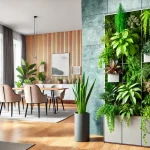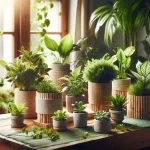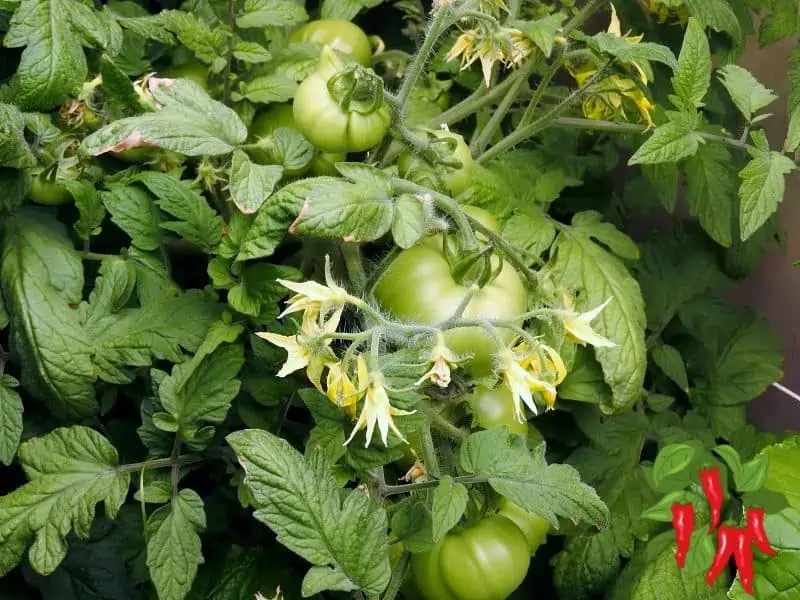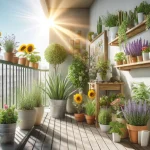This post may contain affiliate links. If you buy something from one of our links we may earn a commission. Thanks
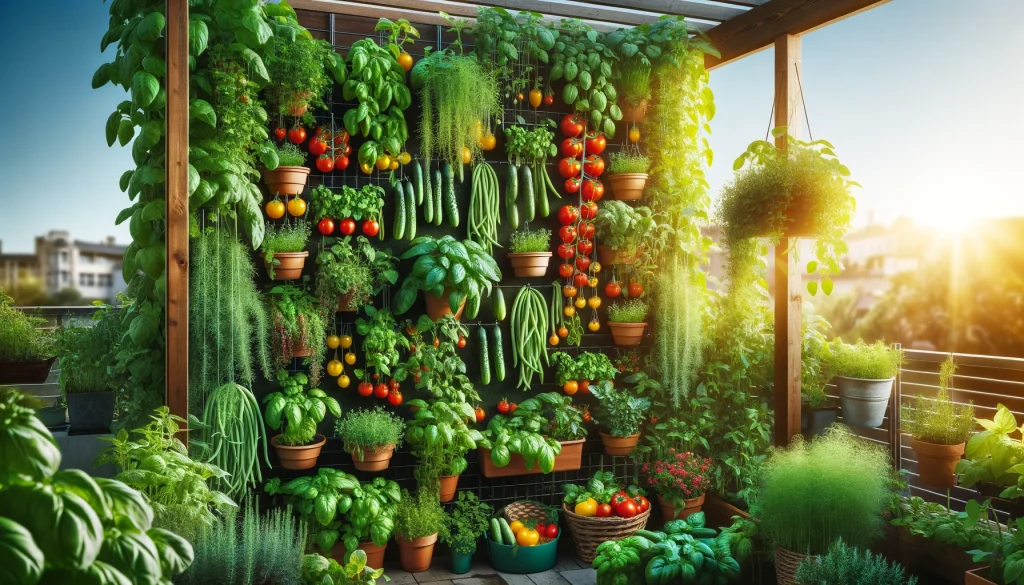
Are you short on space but still want to grow your favorite plants? Vertical gardening might be your solution!
Let’s explore the best plants for vertical gardening, so you can maximize your green space efficiently.
Best Plants for Vertical Gardening
Key Takeaways
- Best plants for vertical gardening include tomatoes, cucumbers, beans, and herbs like basil and mint.
- These plants thrive when grown vertically, saving space and making maintenance easier.
Best Plants for Vertical Gardening
Looking to maximize your garden space and grow more plants? Vertical gardening is your answer!
Vertical gardening is a fantastic way to maximize your garden space. It allows you to grow more plants in less area, making it perfect for small spaces.
By growing plants upwards, you reduce maintenance and improve aesthetics
Let’s dive into the best plants for vertical gardening, perfect for both indoor and outdoor setups.
Whether you use trellises, hanging pots, or grow cabinets, vertical gardening makes your space more efficient and beautiful.
Benefits of Vertical Gardening
- Space-Saving: Ideal for small spaces or urban environments.
- Easier Maintenance: Less bending and kneeling, easier to water and prune.
- Enhanced Aesthetic Appeal: Adds visual interest and green walls to your environment.
Indoor and Outdoor Vertical Gardening Systems
- Trellises: Perfect for climbing plants like tomatoes and beans.
- Hanging Pots: Great for herbs and small flowers.
- Grow Cabinets: Ideal for indoor gardening with built-in lighting and hydroponic systems.
Best Plants for Vertical Gardening Outdoor
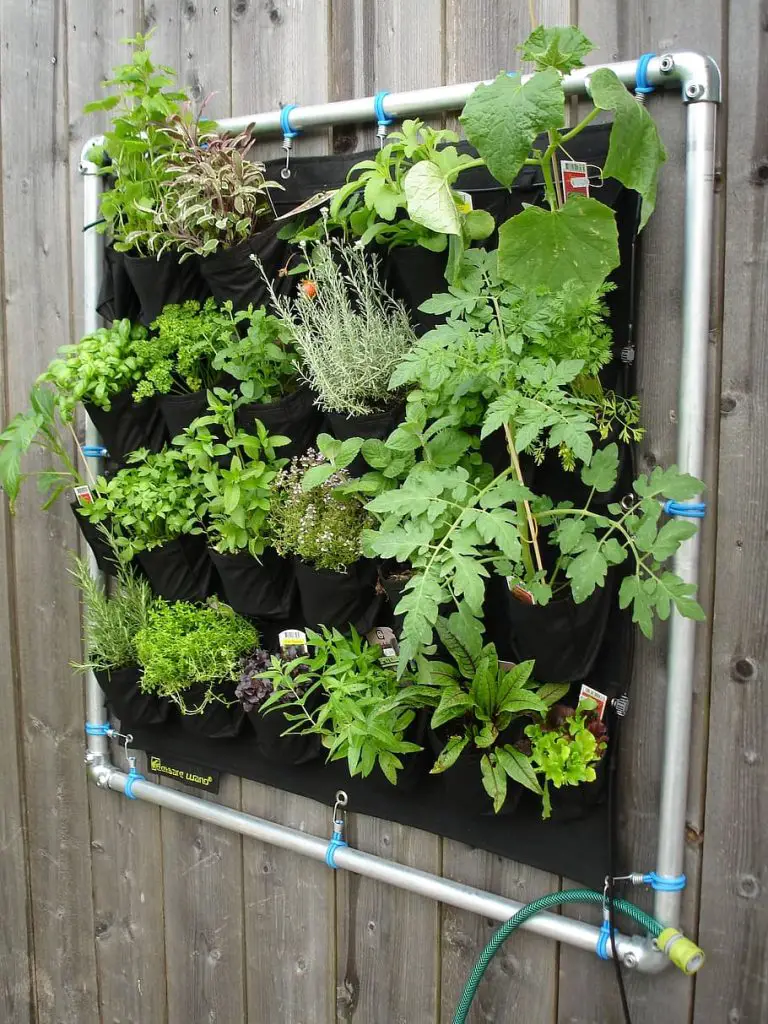
Vertical gardening outdoors opens up a world of possibilities. From colorful flowers to delicious vegetables and fragrant herbs, you can grow a diverse range of plants vertically.
This section covers the best flowering plants, vegetables, and herbs to grow in your outdoor vertical garden.
Flowering Plants
Flowering plants bring beauty and color to your vertical garden. Here are some top picks:
Roses: Climbing roses add elegance and fragrance to any garden. They can cover trellises and arbors, creating a stunning display of blooms.
Clematis: Known for their vibrant flowers, clematis vines can quickly cover vertical structures, offering a burst of color throughout the growing season.
Morning Glories: These fast-growing vines produce beautiful, trumpet-shaped flowers in a variety of colors, perfect for adding charm to fences and trellises.
Vegetables
Growing vegetables vertically not only saves space but also makes harvesting easier. Here are some of the best vegetables to grow:
Tomatoes: Indeterminate varieties of tomatoes thrive when grown vertically, producing a continuous harvest throughout the season.
Cucumbers: Cucumber vines grow well on trellises, keeping the fruit off the ground and making them easier to pick.
Beans: Pole beans are ideal for vertical gardening, providing a bountiful harvest and adding greenery to your vertical space.
Herbs
Herbs are perfect for vertical gardening, offering fresh flavors for your kitchen without taking up much space. Here are some excellent choices:
Basil: Basil grows well in vertical gardens and provides aromatic leaves for cooking all summer long.
Thyme: This hardy herb can thrive in vertical planters and adds a wonderful aroma and flavor to dishes.
Mint: Mint is easy to grow and can spread quickly, making it a great choice for vertical gardening to keep it contained.
Plants for Vertical Garden Full Sun
For those sunny spots in your garden, certain plants thrive with plenty of light. These sun-loving vegetables and flowers will flourish in full sun, adding color and productivity to your vertical garden setup.
Sun-Loving Vegetables
Sun-loving vegetables need plenty of sunlight to grow strong and produce well. Here are some great options:
Best Flowering Plants for Vertical Garden
Flowering plants can turn your vertical garden into a vibrant, colorful display. Whether you prefer seasonal blooms or perennial favorites, there are plenty of options to enhance your vertical space.
Let’s explore some of the best flowering plants for your vertical garden.
Seasonal Blooms
These seasonal blooms are perfect for adding color and life to your vertical garden throughout the year:
Hydrangea Vines: Hydrangea vines produce large, beautiful clusters of flowers that can transform any vertical space. They thrive in partial to full sun and are perfect for covering trellises and arbors.
Honeysuckle: Honeysuckle is a fast-growing vine with fragrant flowers. It attracts pollinators like bees and hummingbirds, making your garden not only beautiful but also lively.
Wisteria: Wisteria vines are known for their cascading clusters of fragrant flowers, which can create a stunning display on vertical structures.
Clematis: Clematis offers a wide range of colors and bloom times. These climbing plants are great for adding vertical interest and continuous blooms throughout the growing season.
Morning Glories: Morning glories are fast-growing vines that produce beautiful, trumpet-shaped flowers in various colors. They are perfect for adding a splash of color to fences and trellises.
Echeveria: While primarily known as a succulent, Echeveria can produce stunning flowers. They are ideal for vertical gardens due to their compact size and low maintenance needs.
Vertical Gardening Systems
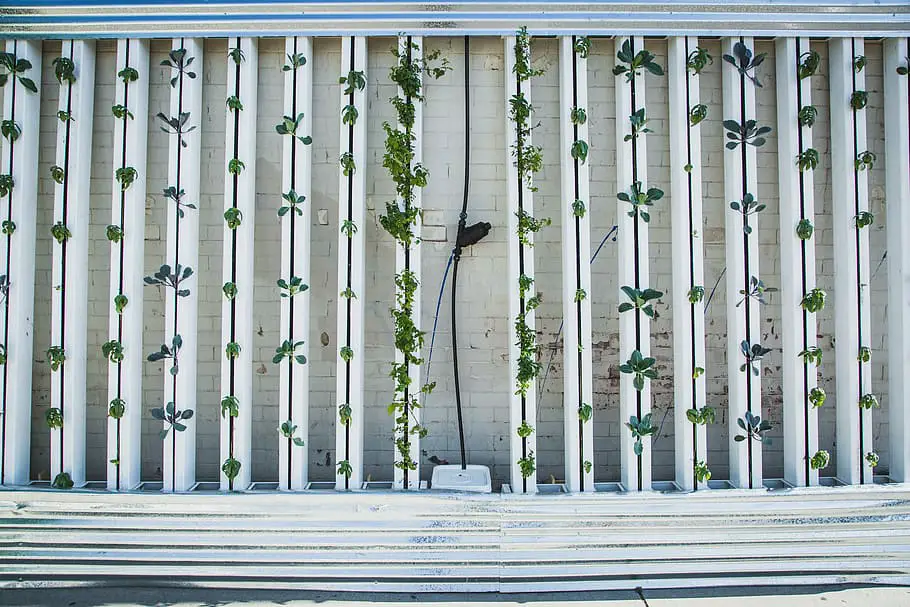
There are several ways to set up a vertical garden, each with its own unique benefits.
Whether you’re working with trellises, living walls, or hanging containers, these systems can help you make the most of your space and keep your garden thriving.
Trellises and Arbors
Description and Benefits:
Trellises and arbors are classic vertical gardening structures that provide support for climbing plants. They help keep plants off the ground, improving air circulation and reducing the risk of diseases.
Suitable Plants:
- Climbing Vegetables: Tomatoes, cucumbers, beans.
- Climbing Flowers: Roses, clematis, morning glories.
Living Walls and Green Walls
Living walls, also known as green walls, are panels of plants grown vertically using hydroponics or soil-based systems.
They can be installed indoors or outdoors and often include a built-in irrigation system.
How to Set Up:
- Choose a Location: Select a wall that receives adequate sunlight. Most plants in living walls need at least 4-6 hours of light per day.
- Select a Frame: Use a sturdy frame that can hold the weight of the plants and the growing medium. Options include modular panels, pallets, or DIY wooden frames.
- Install a Backing: Attach a waterproof backing to protect your wall from moisture. This can be a plastic sheet or a specialized waterproof membrane.
- Add Growing Medium: Fill the frame with a suitable growing medium. For hydroponic systems, use rock wool or coconut coir. For soil-based systems, use a lightweight potting mix.
- Install Irrigation: Set up a drip irrigation system to ensure your plants receive consistent moisture. Hydroponic systems may require a nutrient solution to be delivered through the irrigation.
- Plant Selection: Choose plants that suit the light and water conditions of your location. Mix different types to create visual interest and biodiversity.
- Planting: Insert the plants into the growing medium, ensuring their roots are well-covered. Arrange them to allow room for growth and adequate air circulation.
Best Plant Choices:
- Succulents: Echeveria, sedum, crassula.
- Herbs: Basil, thyme, mint.
- Small Flowers: Petunias, marigolds, pansies.
Hanging Containers
Self Watering Hanging Planters Indoor Outdoor Flower Pots, 6.5 Inch Hanging Basket
Hanging containers are easy to set up and can be hung from balconies, fences, or specially designed stands. Ensure the containers have good drainage and are securely attached to avoid accidents.
Setup Tips:
- Choose Containers: Select containers that are lightweight but sturdy. Make sure they have drainage holes to prevent waterlogging. Containers can be made from various materials like plastic, metal, coco coir, or even recycled materials. Hanging baskets, pots with attached hooks, and fabric pockets are popular choices.
- Select Hanging Spots: Identify strong anchor points such as hooks, railings, or specially designed hanging stands. Ensure they can support the weight of the containers when filled with soil and plants. For example, sturdy ceiling hooks or wall-mounted brackets work well.
- Prepare the Soil: Use a high-quality potting mix suitable for the plants you intend to grow. Avoid garden soil as it can be too heavy and may compact, leading to poor drainage. Consider adding perlite or vermiculite to improve aeration and drainage.
- Planting: Fill the containers with soil, plant your chosen seeds or seedlings, and water them thoroughly. When planting, ensure there is enough space for the roots to grow and that plants are not overcrowded.
- Regular Maintenance: Check the moisture level frequently as hanging containers can dry out faster. Water the plants regularly, especially during hot weather, and ensure that the water reaches the roots. Fertilize periodically according to the plant needs. You may also need to rotate the containers occasionally to ensure even sunlight exposure.
Best Plants for Hanging Containers:
- Herbs: Mint, parsley, chives.
- Small Flowers: Lobelia, ivy geranium, nasturtium.
- Strawberries: Ideal for hanging baskets, providing both beauty and fruit.
Vertical Vegetable Gardening in Small Spaces
36 Pockets Vertical Wall Garden Planter Plant Grow Bag for Flower Vegetable for Indoor/Outdoor
Even if you’re short on space, you can still grow a variety of vegetables using vertical gardening techniques.
With compact varieties and smart planting strategies, you can maximize your garden’s productivity.
Compact Varieties
These compact vegetable varieties are perfect for small spaces and vertical gardening:
Bush Beans: Bush beans are shorter and more compact than pole beans, making them ideal for vertical planters and small gardens. They grow quickly and produce a generous harvest.
Dwarf Tomatoes: Dwarf tomato plants are specifically bred for small spaces. They can be grown in containers or vertical planters and still produce a good amount of fruit.
Mini Pumpkins: Mini pumpkins are perfect for vertical gardening. They can be trained to grow up trellises, saving ground space while providing decorative and edible pumpkins.
Tips for Maximizing Space
Maximizing your space is key when gardening in small areas. Here are some tips to help you get the most out of your vertical vegetable garden:
Using Multi-Tier Planters: Multi-tier planters allow you to grow more plants in a smaller footprint by stacking layers of planters. This is a great way to make use of vertical space and grow a variety of vegetables in a compact area.
Companion Planting Techniques: Companion planting involves growing plants that benefit each other close together. For example, you can grow basil alongside tomatoes to improve flavor and deter pests. This technique not only maximizes space but also enhances plant health and yield.
Vertical Garden Ideas
Vertical gardening is not only practical but also offers a range of creative opportunities to enhance your space. Whether you’re into DIY projects or looking for professional solutions, there are plenty of ideas to explore.
DIY Projects
Creating your own vertical garden can be fun and rewarding. Here are a couple of DIY projects to get you started:
Creating a Pallet Garden:
- Materials Needed: A wooden pallet, landscape fabric, staple gun, potting soil, and plants.
- Steps: Secure the landscape fabric to the back and sides of the pallet to create a pocket for soil. Fill the pallet with soil, plant your chosen herbs, flowers, or small vegetables, and then prop it upright against a wall or fence.
- Benefits: Pallet gardens are affordable, customizable, and perfect for small spaces.
Making a Shoe Organizer Herb Garden:
- Materials Needed: An over-the-door shoe organizer, potting soil, herbs, and hooks.
- Steps: Hang the shoe organizer on a sunny wall or fence. Fill each pocket with soil and plant different herbs in each one. Water the herbs regularly and watch them grow.
- Benefits: This method is an excellent way to recycle materials and create a functional herb garden in a compact space.
Professional Systems
For those looking for ready-made solutions, professional vertical gardening systems offer convenience and efficiency:
Overview of Pre-Made Vertical Garden Kits:
- Description: These kits come with everything you need to set up a vertical garden, including frames, containers, and irrigation systems.
- Examples: Some popular kits include the Woolly Pocket, VertiGarden, and Mr. Stacky. These systems are designed for easy installation and maintenance.
- Benefits: Pre-made kits are ideal for beginners or those who prefer a hassle-free gardening experience.
Hydroponic Vertical Gardens:
Tower Garden Hydroponics Growing System,18-Plant Indoor Vertical Garden with LED Timing Grow Light
- Description: Hydroponic systems grow plants without soil, using nutrient-rich water instead. Vertical hydroponic gardens can be set up indoors or outdoors and often come with integrated lighting and irrigation.
- Examples: Systems like the Tower Garden and AeroGarden are popular choices.
- Benefits: Hydroponic gardens offer faster growth rates, higher yields, and are perfect for growing a wide variety of plants year-round.
Edible Plants for Vertical Garden
Growing your own fruits and vegetables vertically can be both rewarding and space-efficient. Here are some top picks for edible plants that thrive in vertical gardens.
Fruits
Growing fruits vertically can save space and provide fresh produce right from your garden:
Strawberries:
- Benefits: Strawberries are perfect for vertical gardening as they don’t require much space and can be grown in hanging pots or vertical planters.
- Growing Tips: Ensure they receive plenty of sunlight and regular watering. Use a strawberry tower or hanging basket for best results.
Blackberries:
- Benefits: Blackberries can be trained to grow on trellises, making them ideal for vertical gardens. They produce abundant, sweet berries.
- Growing Tips: Plant them in well-draining soil and ensure they have sturdy support as they grow.
Grapes:
- Benefits: Grapes are natural climbers and thrive when grown vertically on arbors or trellises. They provide shade and a bountiful harvest.
- Growing Tips: Prune regularly to maintain shape and improve airflow. Ensure they have full sun exposure and good drainage.
Vegetables
Vegetables are a great addition to any vertical garden, providing fresh produce throughout the growing season:
Indeterminate Tomatoes:
- Benefits: Indeterminate tomatoes continue to grow and produce fruit throughout the growing season. They are ideal for vertical gardening as they can be trained to climb trellises or stakes.
- Growing Tips: Plant tomatoes in a sunny spot with well-draining soil. Regularly prune and tie the vines to the support structure to ensure proper growth and fruit production.
Zucchini:
- Benefits: Zucchini plants can be trained to grow vertically, saving space and making it easier to harvest the large fruits.
- Growing Tips: Use a strong trellis to support the weight of the zucchinis. Water regularly and provide full sun.
Peppers:
- Benefits: Peppers grow well in vertical gardens and can be very productive. They come in various colors and flavors.
- Growing Tips: Plant peppers in containers with good drainage and place them in a sunny spot. Support the plants with stakes or small trellises as they grow.
Spinach:
- Benefits: Spinach is a leafy green that can be grown in vertical planters. It’s nutritious and grows quickly.
- Growing Tips: Spinach prefers cooler temperatures, so place it in a spot with partial shade if growing outdoors. Ensure the soil stays moist but not waterlogged.
Malabar Spinach:
- Benefits: Unlike regular spinach, Malabar spinach is a vining plant that thrives in warm weather and can be trained to climb trellises or fences.
- Growing Tips: Plant in a sunny spot with well-draining soil. Water regularly and provide sturdy support for the vines to climb.
Types of Vertical Gardening
Vertical gardening can be approached in various ways, each with its own unique benefits and methods. Here, we explore hydroponic systems and soil-based systems to help you decide which is best for your gardening needs.
Hydroponic Systems
Gardyn Hydroponics Growing System 4.0 & Vertical Garden Planter
Hydroponic systems grow plants without soil, using a nutrient-rich water solution instead. This method offers several benefits and can be set up relatively easily.
Benefits and Setup:
- Benefits: Hydroponic systems allow for faster plant growth, higher yields, and efficient use of space and resources. They are perfect for indoor gardening and can be used year-round.
- Setup:
- Choose a System: Options include nutrient film technique (NFT), deep water culture (DWC), and vertical hydroponic towers.
- Select a Location: Ensure the area has adequate light, either natural or from grow lights.
- Assemble the System: Follow the manufacturer’s instructions to set up the hydroponic structure and plumbing.
- Prepare the Nutrient Solution: Mix the appropriate nutrients into water according to the needs of your plants.
- Planting: Start with seedlings or cuttings in a growing medium like rock wool or coconut coir. Place them in the system and ensure they receive the nutrient solution.
Suitable Plants:
- Leafy greens like lettuce and spinach
- Herbs like basil, mint, and cilantro
- Fruits like strawberries
- Vegetables like tomatoes and peppers
Soil-Based Systems
Mr. Stacky 5 Tiered Vertical Gardening Planter, Indoor & Outdoor
Soil-based vertical gardening uses traditional soil to grow plants in a vertical setup. This method is simple and versatile.
Types and Benefits:
- Types:
- Vertical Planters: Stacked containers or tiered planters that save space and increase planting density.
- Living Walls: Structures that hold soil and plants in pockets, often with built-in irrigation systems.
- Trellises and Arbors: Support climbing plants, allowing them to grow vertically and save ground space.
- Benefits: Soil-based systems are easy to set up and maintain, suitable for a wide range of plants, and promote natural growth patterns.
Best Practices for Soil Management:
- Choose the Right Soil: Use a high-quality potting mix that is lightweight, well-draining, and nutrient-rich. Avoid garden soil as it may compact and limit root growth.
- Fertilization: Regularly fertilize with balanced, slow-release fertilizers to provide essential nutrients.
- Watering: Ensure consistent moisture levels. Soil in vertical systems can dry out faster, so check regularly and water as needed.
- Mulching: Apply mulch to retain moisture, regulate temperature, and reduce weed growth.
Did You Know
Did you know that coco coir can be used as a hydroponic growing medium or used like conventional potting soil?
By understanding these types of vertical gardening, you can choose the method that best fits your space, needs, and gardening goals.
Best Plants for Vertical Gardening FAQs
Vertical gardening raises many questions for beginners and experienced gardeners alike. Here are some frequently asked questions and their answers to help you get started.
Q: What is best to grow in a vertical garden?
A: Versatile options like tomatoes, cucumbers, and herbs are ideal for vertical gardens. These plants thrive when grown vertically, saving space and making maintenance easier. Tomatoes and cucumbers can climb trellises, while herbs like basil and mint do well in hanging pots or wall planters.
Q: What flowers grow well in vertical gardens?
A: Climbing flowers like clematis and morning glories are perfect for vertical gardens. Clematis offers a wide range of colors and blooms, while morning glories produce beautiful, trumpet-shaped flowers that add a splash of color to any vertical space.
Q: What plants are good for wall gardens?
A: Succulents, herbs, and compact vegetables are great for wall gardens. Succulents like echeveria and sedum require minimal care and water. Herbs such as thyme and rosemary can thrive in wall pockets, and compact vegetables like lettuce and spinach are perfect for small spaces.
Q: What plants are good for wall planters?
A: Non-climbing plants like lettuce, strawberries, and small flowering plants are excellent choices for wall planters. Lettuce grows quickly and can be harvested multiple times. Strawberries provide both beauty and fruit, and small flowering plants like petunias add vibrant color to your garden.
Best Plants for Vertical Gardening Conclusion
Vertical gardening offers numerous benefits, making it an excellent choice for gardeners with limited space or those looking to enhance their gardening experience.
By growing plants vertically, you can maximize your garden space, reduce maintenance efforts, and enjoy a beautiful and productive garden.
Whether you choose to grow vegetables, flowers, or herbs, vertical gardening provides endless possibilities for creativity and efficiency.
Key Takeaways
- Space Efficiency: Vertical gardening allows you to grow more plants in less space, making it ideal for small gardens, balconies, and urban environments.
- Easier Maintenance: With plants grown vertically, it’s easier to water, prune, and harvest without bending or kneeling.
- Aesthetic Appeal: Vertical gardens add visual interest and greenery to any space, enhancing the overall look of your garden or living area.
- Versatility: A wide variety of plants, including vegetables, flowers, and herbs, can thrive in vertical gardens.
- Healthier Plants: Vertical gardening improves air circulation and reduces the risk of diseases, leading to healthier and more productive plants.
Embrace Vertical Gardening
Give vertical gardening a try in your space, no matter its size, and enjoy the many benefits it offers. With the right plants and techniques, you can create a thriving vertical garden that is both beautiful and productive. Start small and see how vertical gardening can transform your gardening experience.
Learn more: Indoor Vertical Gardening: Start Your Indoor Garden Now
Resources for Vertical Gardening
If you’re interested in learning more about vertical gardening, these authoritative resources provide comprehensive information on the topic.
From detailed guides on setting up vertical gardens to the benefits and best practices, these articles will help you get started and succeed in your vertical gardening endeavors.
- Utah State University Extension: This resource offers an in-depth look at creating sustainable school and home gardens using vertical gardening techniques. It covers various setups, benefits, and suitable plants. Creating Sustainable School and Home Gardens: Vertical Gardening (Utah State University Extension).
- University of Florida IFAS Extension: This guide explains the different types of vines suitable for vertical gardening and provides practical tips on establishing and growing your vertical garden. Vertical Gardening – UF/IFAS Extension (SolutionsForYourLife).
- Virginia Cooperative Extension: Detailed information on using trellises, stakes, and cages for vertical gardening, including step-by-step instructions and benefits. Vertical Gardening Using Trellises, Stakes, and Cages (Publications and Educational Resources).
- Kansas State University Research and Extension: An article highlighting the benefits of vertical gardening and tips for maximizing space by growing plants vertically. Maximize garden space by growing vertically (KSRE).
- Clemson University Cooperative Extension: A practical guide on growing tomatoes vertically, including setup tips and benefits. Grow Tomatoes Vertically (HGIC Clemson).
These resources will help you understand the various aspects of vertical gardening, from basic setups to advanced techniques. Dive into these articles to get expert advice and tips for creating your own vertical garden.
Visit my Amazon Influencer Page for videos and gardening products Grow Your Own Garden







